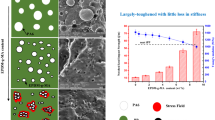Abstract
Fracture behavior of binary blends comprising styrene-butadiene block copolymers having star and triblock architectures was studied by instrumented Charpy impact test. The toughness of the ductile blends was characterized by the dynamic crack resistance concept (R curves). While the lamellar thermoplastic star block copolymer shows elastic behavior (small scale yielding and unstable crack growth), adding 20 wt% of a triblock copolymer (thermoplastic elastomer, TPE) leads to a strong increase in crack toughness. The stable crack propagation behavior of these blends was described by the crack resistance curve (R) concept of elastic-plastic fracture mechanics. This concept allows the determination of fracture mechanics parameters as resistance against stable crack initiation and propagation. Two brittle to tough transitions (BTT) are observed in the binary block copolymer blend: BTT1 at 20% TPE and BTT2 at about 60% TPE. The strong increase of toughness at 60 wt% TPE indicates a ‘tough/high-impact’ transition as a measure for the protection against stable crack initiation.
The kinetics of stable crack propagation is discussed with respect to deformation mechanisms and crack-tip blunting behavior. The analysis of fracture surface by SEM revealed three different types of deformation mechanisms depending on the weight fraction of TPE: coalescence of microvoids (similar to semicrystalline polymers), shear flow (typical of many amorphous polymers like polycarbonate) and tearing (similar to elastomers). Our investigations on nanostructured binary block copolymer blends show new possibilities to tailor the toughness of polymer materials associated with complex morphology-toughness correlations. This may lead to new materials concepts for toughened nanostructured polymers, which still maintain excellent transparency.
Similar content being viewed by others
References
D. A. Tirell, Nature 390 (1997) 336.
Z. R. Chen and J. Kornfield, Polymer 39 (1998) 4679.
T. Hashimoto, S. Koizumi and H. Hasegawa, Macromolecules 27 (1994) 1562.
T. Hashimoto, K. Yamasaki and S. Koizumi, ibid. 26 (1993) 2895.
S. Koizumi, H. Hasegawa and T. Hashimoto, ibid. 27 (1994) 4371.
I. W. Hamley, “The Physics of Block Copolymers” (University Press, Oxford, 1998).
R. Weidisch and G. H. Michler, in “Block Copolymers,” edited by F. Balta Calleja and Z. Roslaniec (Marcel Dekker Inc., New York, 2000) p. 215.
“Thermoplastic Elastomers,” edited by N.R. Legge, G. Helden, H. E. Schroeder and R. P. Quirk (Carl Hanser, Munich Vienna, 1996).
I. Yamaoka and M. Kimura, Polymer 34 (1993) 4399.
I. Yamaoka, ibid 39 (1998) 1765.
ASTM D 6068, “Standard Test Method for Determining J-R Curves of Plastics” (ASTM, Philadelphia, 1996).
Standard Draft ESIS TC4, “A Testing Protocol for Conducting J-Crack Growth Resistance Curve Tests on Plastics” (ESIS, Sheffield, 1995).
P. Will, J. Mater. Sci. 29 (1994) 2335.
W. Brocks, G. KÜnecke and T. Steiger, BAM Research Report No. 1.01 91/3 (BAM, Berlin, 1991).
R. Adhikari, R. Lach, G. H. Michler, R. Weidisch, W. Grellmann and K. Knoll, Polymer 43 (2002) 1943.
“Fracture Mechanics Testing Methods for Polymers, Adhesives and Composites” (ESIS Publication 28), edited by D.R. Moore, A. Pavan and J.G. Williams (Elsevier Science, Amsterdam, 2001).
“Deformation and Fracture Behaviour of Polymers,” edited by W. Grellmann and S. Seidler (Springer, Berlin Heidelberg, 2001).
V. GarcÍa Brosa, C. Bernal and P. Frontini, Eng. Fract. Mech. 62 (1999) 231.
W. Grellmann, S. Seidler, K. Jung and I. Kotter, J. Appl. Polym. Sci. 79 (2001) 2317.
Y. Han, R. Lach and W. Grellmann, ibid. 79 (2001) 9.
K. Knoll and N. Nießner, Macromol. Symp. 232 (1998) 231.
W. Grellmann, S. Seidler and W. Hesse, in “Deformation and Fracture Behaviour of Polymers,” edited by W. Grellmann and S. Seidler (Springer, Berlin Heidelberg, 2001) p. 71.
S. Seidler and W. Grellmann, in “Deformation and Fracture Behaviour of Polymers,” edited by W. Grellmann and S. Seidler (Springer, Berlin Heidelberg, 2001) p. 87.
W. Grellmann and S. Seidler, in “Material Mechanics—Fracture Mechanics—Micro Mechanics,” edited by T. Winkler and A. Schubert (DDP Goldenberg, Dresden, 1999) p. 336.
S. Seidler and W. Grellmann, Intern. J. Fract., Lett. Fract. Micromech. 96 (1999) L17.
W. Grellmann, R. Lach and S. Seidler, in “From Charpy to Present Impact Testing” (ESIS Publication 30), edited by A. Pineau and D. Francois (Elsevier Science, Amsterdam, 2002) p. 145.
R. Adhikari, R. Lach, G. H. Michler, R. Weidisch and K. Knoll, Macromol. Mater. Eng. 288 (2003) 432.
W. Grellmann, S. Seidler and R. Lach, in “Proc. of 3rd International Conference on Mechanics of Time Dependent Materials” (University Erlangen-Nürnberg, Erlangen, 2000) p. 226.
W. Grellmann, in “Deformation and Fracture Behaviour of Polymers,” edited by W. Grellmann and S. Seidler (Springer, Berlin Heidelberg, 2001) p. 3.
H. Blumenauer, E. Schick and R. Ortmann, in “Bruchmechanische Werkstoffcharakterisierung,” edited by H. Blumenauer (Deutscher Verlag für Grundstoffindustrie, Leipzig, 1991) p. 31.
W. Grellmann and R. Lach, Appl. Macromol. Chem. Phys. 253 (1997) 27.
S. Wu, Polymer 26 (1985) 1855.
A. Margolina, Polym. Commun. 31 (1990) 95.
G. H. Michler, Acta Polymerica 44 (1993) 113.
H. Beerbaum and W. Grellmann, in “Fracture of Polymers, Composites and Adhesives” (ESIS Publication 27), edited by J. G. Williams and A. Pavan (Elsevier Science, Oxford, 2000) p. 163.
Y. Han, R. Lach and W. Grellmann, J. Appl. Polym. Sci. 75 (2000) 1605.
W. Grellmann, unpublished results.
“Polymer Blends: Formulation and Performance,” two-volume set, edited by D. R. Paul and C.B. Bucknall (Wiley, New York, 1999).
G. H. Michler, R. Adhikari, W. Lebek, S. Goerlitz, R. Weidisch and K. Knoll, J. Appl. Polym. Sci. 85 (2002) 683.
R. Adhikari, R. Godehardt, W. Lebeck, R. Weidisch, G. H. Michler and K. Knoll, J. Macromol. Sci., Phys. B 40 (2001) 833.
Author information
Authors and Affiliations
Corresponding author
Rights and permissions
About this article
Cite this article
Lach, R., Adhikari, R., Weidisch, R. et al. Crack toughness behavior of binary poly(styrene-butadiene) block copolymer blends. Journal of Materials Science 39, 1283–1295 (2004). https://doi.org/10.1023/B:JMSC.0000013887.79570.33
Issue Date:
DOI: https://doi.org/10.1023/B:JMSC.0000013887.79570.33




